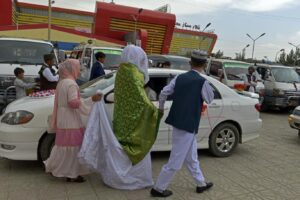KABUL (SW) – While the world is moving at an amazing speed towards the use of renewable energy, especially solar energy to produce electricity, Afghanistan, having 300 sunny days a year and the possibility of producing hundreds of thousands of megawatts of electricity from solar energy, has always faced a shortage of electricity.
Afghanistan depends more on imported electricity from neighbouring countries. According to the statistics of the electricity supply company, Da Afghanistan Brashna Sherkat, now, only 21% of the electricity that is distributed through the public electricity supply network in the country is provided from domestic sources and the remaining 79% is imported from four neighbouring countries.
Access to electricity all the time, which is one of the prerequisites of today’s life and entering the caravan of prosperity, is an unattainable dream for citizens in Afghanistan. Citizens have normal access to electricity for only four months a year, and for the remaining eight months, Afghanistan faces a serious lack of electricity, which has made it difficult for people to carry on their daily lives.
Although during the two decades of the Republic’s rule, many financial resources flowed into Afghanistan and opportunities for development were provided, but the governments of this period did not pay attention to the production of electricity from domestic sources, especially renewable sources, and relied more on importing electricity from neighbouring countries.
Solar power
The construction of solar power plants in Afghanistan started in Kandahar in 2014, and now there are only five active solar power plants in the country with a capacity of 68,184 megawatts of electricity per hour. The production of electricity in these power plants constitutes 7.4% of the total electricity available in Afghanistan’s electricity supply network and 35% of the electricity produced from domestic sources.
1: Three solar power plants are active in Kandahar, with the capacity to produce 40 megawatts of electricity per hour.
2: There is a solar power plant in Herat with a production capacity of 1.7 megawatts of electricity per hour.
3: A solar power plant is active in Bamyan, which has the capacity to produce 1 megawatt of electricity per hour.
According to the statistics of the DABS, in the last two years, not only has there been no investment in the production of electricity from solar energy, but several small solar power plants with a total capacity of 400 kilowatts of electricity have stopped operating due to the depletion of batteries.
Hikmatullah Meywandi, the spokesperson of the DABS, told Salaam Watandar that these power plants include a power plant with a capacity of producing 244 kilowatts of electricity in Takhar, a power plant with a capacity of producing 100 kilowatts of electricity in Paktia, a power plant with a capacity of producing electricity of 30 kilowatts in Logar and the other one is at the DABS building with the capacity of producing 30 kilowatts of electricity.
The limited access to electricity has caused the citizens in different provinces to provide the electricity needed to light their homes by scattered solar energy, and at the same time, farmers in a number of provinces in the fields that have the possibility of irrigating from the water on the ground no, to draw water from the well to irrigate their fields by using the electricity generated from the sun’s energy.
Why is there no investment in solar power generation?
Since the sun’s energy is endless and freely available, it is considered the best option and a sustainable source for electricity production, and its cleanliness has also increased its importance in terms of the environment.
According to the estimate of the solar electricity map of Afghanistan, solar energy constitutes 72.1% of the country’s usable energy and has the capacity to produce 222,849 megawatts of electricity, which shows the current production of solar electricity compared to this figure of 0.03%. .
Due to having the most sunny days in a year, Afghanistan is the best location for the production of solar electricity, which according to the data of “Afghanistan Energy Information Center”, Helmand, Kandahar, Herat, Farah and Nimroz have a production capacity of 33282 MW, 31079 MW, and 28539 MW, respectively – 27137 megawatts and 22618 megawatts of electricity from solar energy – and has the highest capacity of solar electricity generation in the country.
According to experts in the field of electric energy, the wrongness of Afghanistan’s electricity master plan has caused no investment in the production of electricity from solar energy during the republic.
Amanullah Ghalib, the head of the DABS in the previous government, says: “In Afghanistan’s electricity master plan, reliance was placed on imported electricity and domestic sources were very little or little included in the plan, especially solar energy.”
According to Ghalib, the lack of infrastructure, the high cost of producing electricity from solar energy, the lack of a road map and energy policy of Afghanistan, the unwillingness of donors to invest in domestic resources, the lack of funds, the lack of scientific capacity and accurate information, and the lack of strong will are the most important reasons. He cites the lack of financial support and the international banking system in Afghanistan as another reason for not investing in solar power generation.
The current spokesman of the DABS said that the lack of government guarantees due to the caretaker government being under sanctions, the lack of incentive policies in the investment sector, the lack of activity of the World Bank, the Asian Development Bank and other financial donors in Afghanistan, has made it impossible to invest in the production of electricity from solar energy. He added that the DABS cannot implement any project for the production of solar electricity due to lack of funds. But recently, two power generation projects, one of 40 megawatts in Nangarhar and the other of 20 megawatts on the Naglo dam in Kabul, were proposed to this company by private companies.
According to Mr. Ghalib, in the current situation where the government does not have enough funds to invest in the production of electricity from solar energy, only the self-sufficiency of the private sector investment in cooperation with the government and giving financial guarantees to it, can encourage the private sector to invest in the production of electricity from solar energy. The sun, encourage.
Electricity resources
In Afghanistan, since the beginning of electricity production, the traditional method of producing electricity from water sources has been relied on, and still, no extensive investment has been made to produce electricity from other sources, especially renewable sources.
According to DABS statistics, 21% of the electricity available in Afghanistan’s electricity supply network, which is 191 megawatts, is provided from domestic sources, and 79% of it, which is nearly 718.5 megawatts, is imported from four neighbouring countries.
Mayundi, the spokesperson, says that according to the 2023 contract, nearly 1,914,287,243 kilowatt hours of energy from Tajikistan, nearly 2,220,000,000 kilowatt hours of energy from Uzbekistan, nearly 1, 398,087,472 kilowatt hours of energy is imported from Turkmenistan and 800,933,567 kilowatt hours of energy is imported from Iran.
During the two decades of the republic’s rule, Afghanistan tried to end the lack of electricity in Afghanistan by importing electricity from neighbouring countries, but this policy was not enough to meet the needs of the citizens, but with the occasional reduction of electricity in one of these imported networks limit citizens’ access to electricity, especially in winter.
On the other hand, the inadequacy of imported electricity has caused the citizens in the remote parts of the country to have no access to electricity, and the cities are facing a serious shortage of electricity for eight months of the year.
According to DABS’ current estimate, 3,500 megawatts of electricity are needed for citizens to have access to electricity all the time, even in the most remote villages. While now, approximately 909 megawatts of electricity are available in Afghanistan’s electricity supply network.
ENDS






